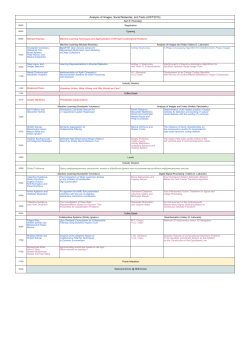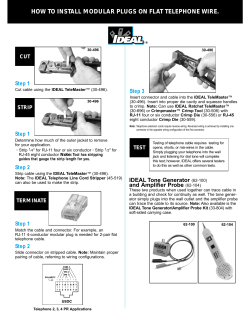
A multipurpose programming cable for radios Pag
Pag 1 to 7 A multipurpose programming cable for radios The programming cable is intended to be used with the computer RS-232 port. Schematic diagram A multipurpose programming cable Page 2 of 7 Connection circuits (jacks for mobile radios are shown as they are plugged into sockets) A multipurpose programming cable GP-340 connector (draft by K. Bokhanov) Page 3 of 7 A multipurpose programming cable Page 4 of 7 VT1, VT3, VT4 transistors can be BC847 or similar, VT2 can be BC857 or similar. The higher the low current beta value is the better. Fast silicon diodes of any type will do, for example LL4148 in MiniMELF case. LP2950 IC is replacible with LM2931 (if input voltage is below 15 V), 78L05 is the worst choice due to the high current consumption. It can fail to work in some cases. Cable for RRxD and RTxD connections should be shielded. Multiwire cable with low mutual capacitance among wires is also applicable. Otherwise TxD to RxD interference will result in programming failure. It is important for some KENWOOD radios. It is convenient to use an additional connector to attach particular radio jacks to the programming cable. DB9 is recommended as a highly reliable one. Cable connection to KENWOOD portable radios has a specific feature. Radio sockets have prominent rubber rings, thus standard stereo jacks cannot be plugged in firmly. The jack flanges should be ground off till 5 mm in diameter. The jack cases should be cut accordingly. TK-353 radios are put in the program mode by holding the side button below PTT and C button while powering the radio on. Hold the buttons until "--PC--" appears on its display. In MOTOROLA GP300 сonnector use 2 Ampere diode if you intend to transmit with the cable connected or 1 Ampere diode otherwise. In MOTOROLA P040-P080 сonnector grind off the jack flange until the jack can be seated firmly. This connector does not need an external power supply if it is provided from the port by a programming software. MOTOROLA mobile CM series radios are programmed through the rear accessory connector. The programming cable is not powered from the port. The power supply can be taken from the radio power supply or the accessory connector if available. In MOTOROLA GP-340 connector the output voltage is limited to approximately 3 Volts. The specific jack is used, it is shown on Fig. 4. VERTEX VXR-5000 and VXR-7000 programming software works improperly on modern computers with fast processors. Computers with i80486 are recommended by VERTEX, iCeleron 433 MHz processor may be also applicable. A connection to devices with a non-standard processor supply voltage (cordless and cellular phones) requiers a special connector. A TxD key power is taken from the phone, so the input logic levels cannot exceed the processor supply voltage. For example SENAO SN-258 is attached by its test connector in this way: TxD - cont. 1, RxD - cont. 2, GND - cont. 3, Vbat - cont. 5. R1 resistor may be omitted because the phone RxD cirquit has an inner 47 kOhm resistor to the ground. The cellular phones connector can be used for applying AT-commands to phones. There are no hardware flow control cirquits in the connector. The Siemens phone socket pinout is from www.pinouts.ru. The programming cable printed cirquit board was designed by Valery UA6LPG with non-chip components. In order to print it save the GIF image to disk. Then open the GIF file with Adobe Photoshop (or any other editor) and change the image resolution to 600 dpi (look for at Image/Image size). Print it, it will be of the right size. A multipurpose programming cable Page 5 of 7 Programming cable PCB and silkscreen (designed by Valery UA6LPG) Please note, that R12 is omitted on the PCB, Rind resistor and a LED are added between the DA1 output and the ground to indicate the power. You can omit R12, Rind and a LED, the cirquit will work. Some words are in Russian, the most significant words are translated. The recommended value of Rind is 4.3 kOhm to minimize the current consumption. Siemens A35, A36, A40, C25, C35, C45, M35, M35i, M50, ME45, MT50, S25, S35, S45, SL-42, SL45, 3118 cell phones pinout pin-outs Applicable to A/C/S/M/SL 2x, 3x, 4x, 5x, x25, x35, 3508, s2588? Full pinout. 12 pin Siemens Lumberg mobile special connector at the mobile phone Pin Name 1 GND SELF2 SERVICE 3 LOAD 4 BATTERY DATA 5 OUT (TX) DATA IN 6 (RX) Dir Description Ground Recognition/control in/out battery charger in Charging voltage out Battery (S25 only) out Data sent in Data received A multipurpose programming cable Page 6 of 7 7 Z_CLK - 8 Z_DATA - 9 MICG - 10 MIC 11 AUD in out 12 AUDG - Clock line for accessory bus. Use as DTC In data operation Data line for accessory bus. Use as CTS in data operation Ground for microphone Microphone input Loudspeaker Ground for external speaker The programming cable was tested with 66 device types, i.e. KENWOOD TK-260G (by Valery UA6LPG), TK-270G (by Sergey RU3VV, Nikolay Novakov, Gorodnov), TK-278 (by Yevgueny RA9MHL, Igor Marzaganov), TK-2107 (by Vladimir Yasakov, the author, Sergey UA9UDQ, Ivan UX7MX, Igor Marzaganov), TK-2160 (by Nikolay Novakov), TK-3101 (by Alexander 'Gulliver'), TK-353, TK-360, TK-360G, TK-370 (by Alexander 'Gulliver'), TK-370G (by Sergey UA9UDQ), TK-378, TK-759 (by Alexander 'Gulliver'), TK-7020 (the same as TK-7108, KPG70D software - by Yuri US5IVZ), TK-760HG-1 (by Sergey UA9UDQ), TK-8102, TK-840, TK-860G-1, TK-860H, YAESU / VERTEX FT-41R, VX-1R (by Yevgueny RA9MHL), VX-160 (by Veniamin Dolgikh), VX-180 (by Veniamin Dolgikh), VX-200 (by Yevgueny RA9MHL), VX-210AU, VX-300 (by Igor RA0FMF, Alexander Kiselyov), A multipurpose programming cable Page 7 of 7 VX-500 (by Yevgueny RA9MHL, Alexander 'Gulliver'), FTL-1011 (by Nikolay Novakov, Alexander Kiselyov), FTL-2011 (by Veniamin Dolgikh, Alain Seguin, Yuri RA9SVD), VXR-5000 (by the author, a computer with the iCeleron 433 MHz processor), VXR-7000 (by Alexander Tataurov, a computer with the i80486 processor), VX-2000 (by Yevgueny RA3ZMB), VX-5R (by Igor RA0FMF), VX-3000 (by Sergey UA9UDQ), FT-10R (by Alexander 'Gulliver'), FT-40R (by Alexander 'Gulliver'), VX-10 (by Igor Marzaganov, the author), FT-11R (by Igor Marzaganov), VX-400 (by Igor Marzaganov), FT-51R (by Dmitry UA2FBB); MOTOROLA P040 (by Veniamin Dolgikh, Stan UN8GA), P080 (by Valery UA6LPG, Pavel UA1ZCC), P110 (by Igor Marzaganov), CM-160 (by Vadim UA9MIR), GM-160 (by Andrey Aladyin), GM-300 (by the author, Sergey RU3VV, Yevgueny RA9MHL, Valery UA6LPG, Igor Marzaganov), GP-300 (by the author, Yevgueny RA9MHL, Igor RA0FMF, Valery UA6LPG, Igor Marzaganov), GP-340 (by Vadim UA9MIR), GM-350 (by Sergey RU3VV, Yevgueny RA9MHL, Gorodnov, the author, Valery UA6LPG), GM-360 (by Valery UA6LPG), LTS 2000 (by Alexander 'Gulliver'), MAXTRAC (by Alexander 'Gulliver'); ICOM IC-F410, IC-F320 (by Valery 4Z5PT, Alexander 'Gulliver', Veniamin Dolgikh), IC-F3 (by Valery UA6LPG, Alexander Kiselyov, Igor Marzaganov), IC-F3GS (by Igor RA0FMF, Valery UA6LPG, Igor Marzaganov), IC-F10 (by Pavel UA1ZCC), IC-F11 (Valery UA6LPG); ALINCO DR-135 (by Sergey UA9UDQ, Dmitry UA2FBB), DR-140 (by Sergey UA9UDQ), DJ-195 (by Sergey UA9UDQ, Pound, Igor RA0FMF), DJ-191 (by Alexander 'Gulliver', Igor RA0FMF); CI-V interface: OPTOELECTRONICS DC440 decoder (YAESU / VERTEX 3-contact connector); SIEMENS cellular phones (AT-commands): C35, ME45, SL45i. The author especially appreciates the collaboration of Sergey UA9UDQ, Yevgueny RA9MHL, Valery UA6LPG, Alexander 'Gulliver' in verifying the schematics and testing radios.
© Copyright 2025











